
India’s Burma Currencies
Currency Notes
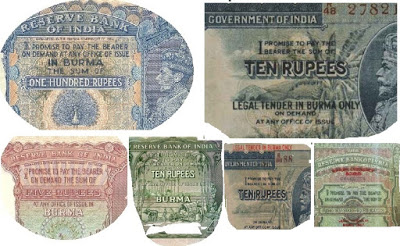
Quote:
“…….I live in Yangon, Myanmar. I am working at Myanmar Apex Bank (MAB) as Assistance Manager. In my work, I am in touch with money every day. I am interesting about old paper money that used in Myanmar and I want to learn. There is no Myanmar author/writer who writes about old paper money of Myanmar. So I want to write about these. But I have no old banknotes and not enough money to buy it. All I only do is to learn, to find the data and to ask questions to professional. This is the reason for query…………..”
“Questions
- Were Victoria Portrait Series Banknotes (1861-66) used in Burma after the British occupation of Burma?
- Were the Re1 Notes (King V) used in Burma?
- I cannot find about Green Unifaced 20 and 50 Rupees Banknotes for Rangoon Circle. Could you explain me about that with full of details? Or could you indicate the websites which include about it?
- Were King George V High Denomination Origin Notes (without Legal Tender Text) used in Burma?”
:Unquote
The authors from whom I took permission were Mr. Peter Symes who is a publisher of World paper Money and has several articles to his credit on Currencies, Bank Notes and Stamps, Shri Tom Chai, an ex electronics Engineer at U.S and a Gold award winner for his Web site on Money Gallery, and Shri Anurag Vaishney, senior software engineer of Noida. All of them readily accorded their kind permission through E-Mail to use their web collections for my project.
The present article too is widely based on inputs from my original project and also meant for educating larger community and published without any commercial interest of any nature, I wish to once again thank the same authors and give due credits to them, wherever they are now, for having given consent several years ago to use some inputs from their sites. Also due credits and thanks to some of the websites from where the illustrations of currencies have been taken and collaged for explaining the contents. PLEASE NOTE THAT NONE OF THE CONTENTS OF THIS ARTICLE SHOULD BE USED FOR COMMERCIAL PURPOSE OF ANY SORT AS IT IS MEANT ONLY FOR EDUCATIVE PURPOSE TO ENHANCE THE KNOWLEDGE.
Indian Currencies
used in Burma
When the Paper money was introduced they were referred to in different names such as Bills of exchange, Paper Money, Notes etc, even though all of them represented real money or Currencies for exchange. For better understanding of the topic the paper money used in different names are generally referred to as Currencies in this article.
Few banks which first began issuing the Paper Money were the ‘Bank of Hindostan’ which existed during 1770 to 1832 , the ‘General Bank’ in Bengal and Behar (which is now Bihar) which existed during 1773-75 and the ‘Bengal Bank’ which existed during 1784-91.
Paper Money or Currencies in general came to enjoy wider acceptance by traders after the establishment of few Semi-Government banks like ‘Bank of Bengal’ in the year 1806, the ‘Bank of Bombay’ in 1840 and the ‘Bank of Madras’ in the year 1843. However the acceptance was restricted to very small class of privileged users in the business sector.During East India Company rule in India, two private Banks in the name of ‘Commercial Bank’ and ‘Union Bank’ came up in the then Bengal Province in the first half of 18th century and they too began issue of Paper Money in the form of bills of exchange or some kind of financial instruments for transacting the business. Later some years, two more Banks in the name of ‘Bank of Western India’ in the then Bombay Presidency and ‘Asiatic Bank’ in the then Madras Presidency also emerged. Noticing the profits of the banking business, in the later part of 18th Century, the East India Company entered into the Banking business by establishing three ‘Presidency Banks’ in the then Madras, Bombay and Bengal Presidencies. This development further led to the circulation of money in the form of paper. From then on, slowly money began to be circulated in the form of Paper Money both by the Private banks and the banks under East India Company. Perhaps those financial instruments on paper represented the real money and paved way for the emergence of Paper Currencies or Bank Notes as issued and circulated in India much later. However since the financial instruments that represented the real money were only issued by the individual banks in their personal capacity, their use and circulation were limited within the trading community who continued to exchange them for money based on mutual trust. There were no appreciable security or design features on those Paper Money and most of them were very simple in design aspect and printed on hand made paper.
Amongst the three Presidency Banks established by the East India Company, only ‘Bank of Bengal’ was authorized to issue the financial instrument on paper then known as Notes or Paper Money and were used for payment of Public revenues and other limited transactions of the establishment. The trend continued till 1860 when one of the Finance members of the Establishment (govt) mooted the idea of authorized legal Paper Money to be issued and guaranteed by the state itself from a single window superseding the issue of
Paper Money by different Banks in their individual capacity. This resulted into enacting the Paper money act in the year 1861.The Paper Money Act of 1861 conferred upon the Government of India the monopoly of issuing the Currencies and prohibiting the Private and Presidency Banks from issuing Paper money in any form. The Paper Money Act 1861, also authorized the Presidency Banks which had been earlier established by the East India Company, to enter into agreements with the Secretary of State of the Govt for becoming the agents of the state for the issue, payment and exchange of Paper money.
In this direction some Currency issuing circles were also created. There were only three Currency issuing circles operating initially. In the year 1862, the Government increased the Currency issuing circles by opening new circle in Calcutta in addition to the already existing circles in Madras, Bombay and Bengal. Since operating, managing and coordinating the issue of Currencies with the agent Presidency banks increasingly becoming difficult, the Govt began terminating the agency services of the Presidency Banks and prohibited them from issuing and circulating the Currencies. In the year 1865 the services of Bengal Bank was suspended followed by the termination of services of Bombay and Madras circles in the year 1867. After terminating the agency services of the Presidency Banks, the management of the Paper Currency was entrusted to the Mint (Coins producing unit) Master of Calcutta by designating him as Head Commissioner for Issue of Currencies.
After centralizing the Currency issuing authority, Currency issuing circles were also increased by opening new issue circles in Kanpur, Rangoon and Karachi in addition to already functioning circles in Calcutta, Bombay and Madras. With the emergence of more Currency circles and clamor for Paper Money increased, the magnitude of Currency circulation too increased both in terms of value and volume. Therefore the management of paper Currency was again taken away from the Mint master and entrusted to the Controller of Currency, an independent authority created to manage the entire Currency affairs. The Currencies were universalized and became legally encashable across the country whichever were under the control of the then British Government of India.
Paper Currency was managed by the Government of India till 1934 when the Reserve Bank of India was established as the Central Bank of the country to manage entire Currency affairs even as British Govt was ruling the country. Once RBI was established through an act, it took over the function of Currency issue from the Office of the Controller of Currency. Currencies issued by the Reserve Bank of India became legal tender, encashable at any place in India for payment and the value indicated on the Currencies remained guaranteed by the Government.
A Currency is generally considered as a type of negotiable instrument known as a promissory note and is issued by an authorised bank of a country. The amount indicated in the same are payable to the bearer on demand as every Currency is incorporated with promising clause assuring to pay the specific sum indicated in each Currency. For this purpose each Currency also carry the signature of the authorised person on the same Currencies. This is the main principle of the Paper Money.
It is interesting to note that in the midst of all the developments as mentioned above and even before the formation of RBI the Indian Currency were in use as the official Currency in several other neighboring countries that were under the British rulers and governed from India, and one such country was Burma besides Pakistan, East Africa, Southern Arabia and the Persian Gulf. After Burma was annexed by the Britishers and kept as one of the provinces in Indian territory, they had put into circulation the very same Indian Currencies used in India but printed with imprint ‘for use in Burma’ or ‘Legal Tender in Burma’. Being adjacent to Bengal, for administrative convenience and financial activities, the Britishers kept Burma under the Presidency of the then Bengal which is now known as West Bengal. Therefore the Indian Currencies in circulation then in India were also used by the Britishers as Currencies for Burma with imprint mentioned above.
When the Paper currencies of India were introduced in Burma they were over printed with an imprint mentioning ‘Legal tender in Burma only’. The Japanese occupation and
subsequent liberation of Burma during World War II saw Burma administered by the Military Regime for short period of time. After stabilizing the affairs of the state, the Military Regime handed over the administration to Civilian rule in the year 1946 and the Civil administration constituted ‘Burma Currency Board’ to manage the affairs of the issue and circulation of the Currencies for carrying out the financial activities.After Burma was liberated from brief occupation of Japanese forces, when it was placed under a military administration Indian Currencies in the value of Rs 5/-, Rs 10/- and Rs 100/- denominations were put to circulation for use by the Military Regime in Burma. The Currencies bore imprint in Red color – ‘Military administration of Burma, Legal tender in Burma only’. Some of those notes had the signature of Governor C.E. Jones and C.D.Deshmukh. Those meant for civilians were overprinted with imprint ‘Legal tender in Burma only’, and those issued for Military Regime were imprinted as ‘Military Administration of Burma-Legal tender in Burma only’ indirectly implying that such imprinted Currencies cannot be used in India. After the formation of Reserve Bank of India, and even after the formation of Burma Currency board under Civilian rule, the Reserve Bank of India continued to issue Indian Currencies for use in Burma with imprint reading ‘Burma Currency Board- Legal Tender in Burma only’. This was done to safeguard and strengthen the financial activities in Burma and to curb illegal transactions.
In terms of value, Currencies used in Burma remained at par with the Indian rupee. In the year 1935 when the Government of India Act came into force, the financial affairs of Burma were still continued to be managed by the British Indian Government. This facilitated the Central Monetary Authority of British India to issue Currencies on behalf of Burma for use there. After the formation of newly established Reserve Bank of India, it could not issue separate Currencies for Burma but instead put to circulation till 1938 the then Indian Currencies with some imprint indicating their legal use in Burma.
No paper money was issued by Burma till 1937 and only Indian Currencies with imprint ‘Legal tender in Burma only’ were used under the British Empire. However even before Burma was separated from India in the year 1938, the Reserve Bank of India took the responsibility of issuing the Currencies under a treaty called Burma Monetary Arrangements Order, 1937. As per the treaty, RBI would continue to issue Burma Paper Money which were legal tender in Burma, but not legal tender in India.
After the restoration of a Civil Govt in the year 1946, the financial administration was given to a Governmental body named ‘Burma Currency Board’ which too deployed the Indian Currency over printed with imprint ‘Burma Currency Board / Legal Tender in Burma Only’. An interim act enacted by the British Govt facilitated the continued use of Government of India Currencies in Burma with the Portrait of King George V on various denominations such as Rs 5/-, Rs 10/- and Rs 100/- carrying an imprint ‘Legal Tender in Burma Only’ till such time the Burmese Govt could began to print the Currencies of their own. Most of them carried the signature of Governor J.W. Kelley on behalf of the Govt.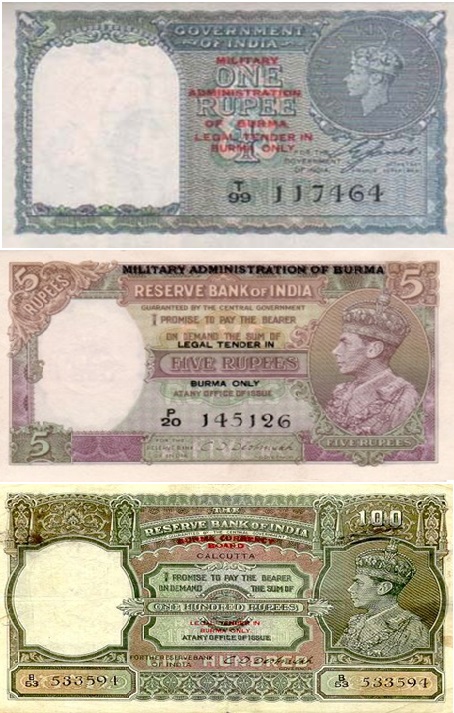
After Burma gained complete independence in the year 1948, the title of the Currency issuer had changed to ‘Government of Burma’. Only Re 1/- and Rs 5/- Currencies were issued under that name. In 1949, the name of issuer of the Currency was changed to ‘Government of the Union of Burma’. Only Rs10/- and Rs 100/- Currencies were introduced under issuer’s name.
However in order to streamline the circulation of Currencies in Burma, as an interim measure some of the Indian Currencies in denominations of Rs 5/-, Rs 10/- and Rs 100/- were got printed from the security press in India itself, overprinted with an imprint ‘Burma Currency Board, legal tender in Burma only’ and put them to circulation for provisional use from the year 1947 till 1952 when Indian Currencies used in Burma was totally demonetized. In 1952, ‘Union Bank of Burma’ took the responsibility of issuing the Currencies. Re1/-, Rs 5/-, Rs 10/- and Rs 100/- denomination Currencies were issued. replacing the word ‘Rupees’ with ‘Kyat’ but the designs did not change. In 1958, the Peacock image from those Currency was replaced with Aung San, and the new 20 and 50 kyats Currencies were introduced.
Currencies used in Burma:
- Reserve Bank of India Currencies over printed with imprint ‘Legal Tender in Burma only’ were issued for denominations Rs 5/-, Rs 10/-, Rs 100/-, Rs 1000/- & Rs 10000/-.
- Reserve Bank of India Currencies over printed with imprint ‘Military Administration of Burma- Legal Tender in Burma only’ were issued for denominations Re 1/-, Rs 5/-, Rs 10/-, Rs 100/-.
- Government of India Currencies over printed with imprint ‘Currency Board of Burma’ were issued for denominations Re 1/-, Rs 5/-, Rs 10/-, Rs 100/-.
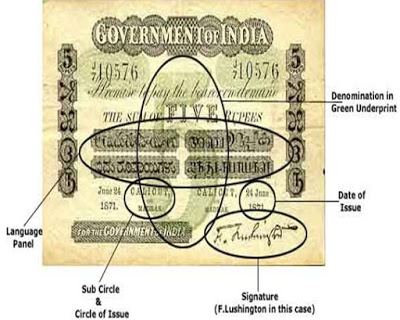
The Unifaced ‘Under print Series’ (print on print) currencies were introduced in the year 1867. The Green Under print Series Currencies had security feature such as a Green under print denoting the denomination, guilloche patterns as design elements over printed on them. The said Currencies had some sort of watermark too and the quality of hand made paper used for printing them were better. The inbuilt watermark incorporated a code that indicated the year and date of manufacture of the paper. Initially those currencies were meant to be circulated only in the Currency Circle in which they were issued.
Between 1904 to 1909 Rs 5/- denomination currencies were issued with green under print carrying the signatures of F. Atkinson and H. J. Brereton. Between 1897 till 1907 Rs 10/- denomination currencies with the signatures of R.E. Hamilton and Williams Wells were issued. Rs 50/- denomination currencies were issued in the year 1901 to 1910 from Rangoon. Rs 100/- denomination is reportedly issued in the year 1918 and signed by A.C. McWattersn H. Denning and M. M. S. Gubbay . However details on the the quantity of currencies issued are not known.
The significant design features of those Currencies were inclusion of Burmese and Chinese languages along with Hindi and Urdu languages while displaying the numeral value of the currencies in words. The numeral value was found printed in bold numeral in centre of the currencies in green colour. Hence those Currencies were called Green Under print currencies and they carried the date, month and year of issue besides the place of issue circle in a single alphabet.
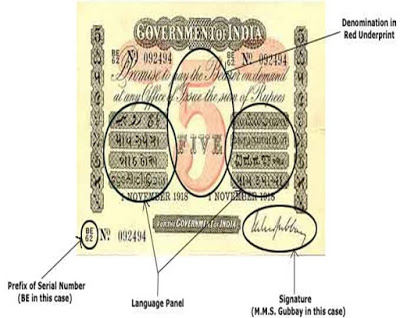
Red Under Print Series:
Later when it was realized that paper money was becoming more popular and the rigidity that they could be used only within the circle in which they were issued was relaxed to enable encashment of those Currencies in all areas under the control of the Govt. The major design change incorporated in those Currencies was promissory clause that read ‘promise to pay the bearer at any office of issue’. The Green colour under print was changed to Red colour under print. While the Green under print currencies the value of the currency was shown in four languages, The Red colour under print series Currencies displayed the value in eight languages such as Urdu, Kaithi, Bengali, Burmese, Telugu, Tamil, Kannada and Gujarati. The reason for the omission of Chinese language is not known. With forgery /counterfeit problem effectively checked by the fresh issue of Red Under print series, when more and more people began to use paper currencies, those travelling in various parts of the country were faced with the problem of use of the paper Currencies beyond the circles from where they were issued. In order to solve this problem, the Government introduced Red under print Currencies with additional features which could be used anywhere in the country under the then Govt. The Red under print Currencies thus paved way for wider use of Paper Money in any part of the country. Between 1903 and 1911, Currencies in denominations of Rs 5/-, Rs 10/-, Rs 50/- and Rs 100/- were issued and permitted to be legally encashable outside the Currency Circle of Issue. However, the names of the issuing circles were retained in those notes either in full form or by way of single alphabet . This series remained largely unchanged till the introduction of the ‘King’s Portrait’ series which commenced in 1923.
Between 1908 to 1918 Rs 5/- denomination Currency was issued with Red Under print with the signatures of R. W. Gillan. Between 1912 till 1918 Currency in Rs 10/- denomination with the signatures of M. M S. Gubbay, R. W. Gillen, H. F. Howard were issued. While the denomination of Rs 5/- contained the value of the Currency in eight languages, in respect of Rs 10/- denomination English was added to denote the value. Rs 50/- denomination Currency was issued in the year 1901 to 1910 from Rangoon. Rs 100/- denomination is reportedly issued in the year 1918 and signed by A.C. McWattersn H. Denning and M. M. S. Gubbay. However details on the the quantity of Currencies issued could not be gathered.
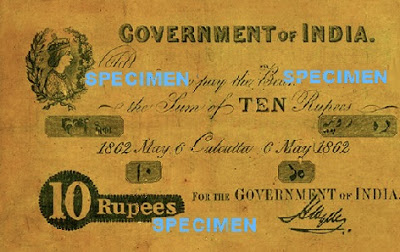
Victoria Portrait Series :
The Currency notes with the portrait of Queen has been issued by Government of India in 18th century. The said Currencies had two language panels, water mark, very light designs and printed on hand made paper. Much later, some time before issue of King George V series Currencies with Victoria portrait in denominations of Rs 10/-, Rs 20/-, Rs 50/-, Rs 100/-, Rs 500/- and Rs 1000/- have been issued by the Govt of India. It is not clear to the author whether the Victoria series Indian Currencies have been used by Burma.
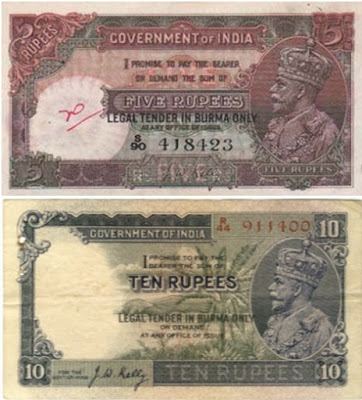













Recent Comments